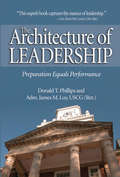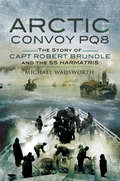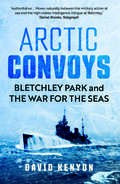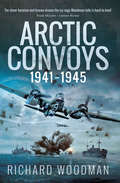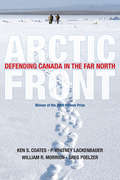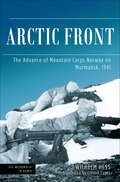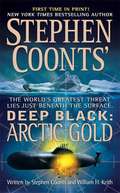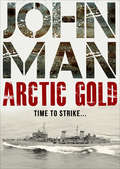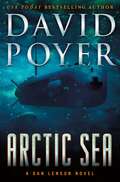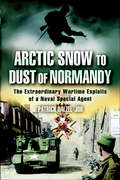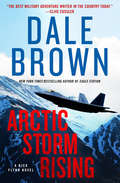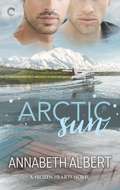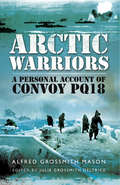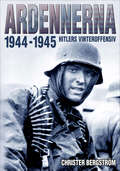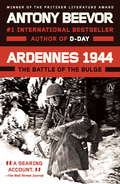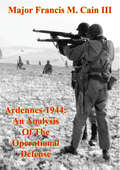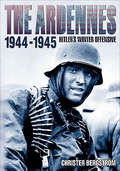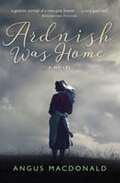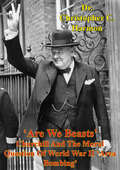- Table View
- List View
The Architecture of Leadership
by Donald T. Phillips James M. LoyThe Architecture of Leadership is a simple but effective toolkit for leaders, whose main theme is "preparation = performance." Using the elements of architecture, they begin with a foundation of character and values, move to a floor representing a drive to achieve combined with the capacity to care, and continue with the framework of innate traits and acquired skills to the ceiling and roof of opportunity and performance, respectively. Supporting it all are the pillars of honesty, integrity, courage, respect, commitment, trust, ethics, and hard work.
Archives of War: Technology, Emotion and History (Media, War and Security)
by Debra RamsayThis book offers a comparative analysis of British Army Unit War Diaries in the two World Wars, to reveal the role played by previously unnoticed technologies in shaping the archival records of war. Despite thriving scholarship on the history of war, the history of Operational Record Keeping in the British Army remains unexplored. Since World War I, the British Army has maintained daily records of its operations. These records, Unit War Diaries, are the first official draft of events on the battlefield. They are vital for the army’s operational effectiveness and fundamental to the histories of British conflict, yet the material history of their own production and development has been widely ignored. This book is the first to consider Unit War Diaries as mediated, material artefacts with their own history. Through a unique comparative analysis of the Unit War Diaries of the First and Second World Wars, this book uncovers the mediated processes involved in the practice of operational reporting and reveals how hidden technologies and ideologies have shaped the official record of warfare. Tracking the records into The National Archives in Kew, where they are now held, the book interrogates how they are re-presented and re-interpreted through the archive. It investigates how the individuals, institutions and technologies involved in the production and uses of unit diaries from battlefield to archive have influenced how modern war is understood and, more importantly, waged. This book will be of much interest to students of media and communication studies, military history, archive studies and British history.
Arctic Blast (The Executioner #288)
by Don PendletonWhile attempting to discover why a new anti-missile defense sysstem malfunctioned, Mack Bolan discovers a potential attack to destroy all of the American Southwest!
Arctic Convoy PQ8: The Story of Capt Robert Brundle and the SS Harmatris
by Michael WadsworthWhen Robert Brundle took the SS Harmatris to Russia with Convoy PQ8 he was 47 years of age. Both ship and master were veterans and had already sailed in convoys across the North Atlantic and to South Africa. The 5,395 ton coal fired ship, laden with 8,000 tons of armaments originally set sail on 27 November 1941 to join convoy PQ6 but encountered a fierce storm in which a lorry broke free in the hold and started a fierce blaze below decks. Despite valiant attempts to extinguish the fire the Harmatris was forced to return to Glasgow for repair. Having discharged its cargo, examined and repaired the holds, it restowed and finally put to sea again on 26 December. She was now to join PQ8 and Brundle was elected Convoy Commodore. Two minesweepers, a cruiser and two destroyers escorted the eight merchant vessels.On 8 January the convoy left Reykjavik bound for Murmansk. Harmatris was struck by two torpedoes in No 1 hold which caused flooding. A third torpedo struck her a few hours later and the crew evacuated to HMS Speedwell in attendance. A volunteer crew reboarded and Speedwell took the wounded ship in tow. During the night the same U Boat that had struck Harmatris sunk the destroyer Matabele with the loss of all but two of her crew. A tug eventually replaced Speedwell and the entire crew now returned to their still stricken vessel. On 18 January the ships were twice attacked by low flying Heinkels. The stricken Harmatris finally berthed in Murmansk at 0800 on 20 January. Once unloaded the battered ship entered dry dock on 10 February. The damage was considerable. In a temperature of 40 degrees below zero the crew set about the repairs. It was difficult to locate engine parts and local labor was scarce.During the following months the crew continued to work on the ship, food was scarce and the port was frequently bombed by the Luftwaffe. Several ships close to Harmatris were sunk. It was 21 July when the ship finally left for Archangel. She took aboard a cargo of 3,000 tons of steel pipes and on 13 September she was instructed to join a convoy of 20 ships, QP14 for her return voyage. On 19 September the minesweeper HMS Leda, steaming close by Harmartris, was torpedoed. The convoy was under almost continuous U Boat attack and suffered six losses. As a result of his heroic efforts to preserve his ship and crew Captain Brundle was awarded the OBE and the Lloyds War Medal. He died in 1960 at the age of 66.
Arctic Convoys: Bletchley Park and the War for the Seas
by David KenyonAn incisive account of the Arctic convoys, and the essential role Bletchley Park and Special Intelligence played in Allied success Between 1941 and 1945, more than eight hundred shiploads of supplies were delivered to the Soviet Union protected by allied naval forces. Each journey was a battle against the elements, with turbulent seas, extreme cold, and the constant dread of torpedoes. These Arctic convoys have been mythologized as defenseless vessels at the mercy of deadly U-boats—but was this really the case? David Kenyon explores the story of the war in the Arctic, revealing that the contest was more evenly balanced that previously thought. Battles included major ship engagements, aircraft carriers, and combat between surface ships. Amid this wide range of forces, Bletchley Park’s Naval Section played a decisive role in Arctic operations, with both sides relying heavily on Signals Intelligence to intercept and break each other’s codes. Kenyon presents a vivid picture of the Arctic theater of war, unearthing the full-scale campaign for naval supremacy in northern waters.
Arctic Convoys 1941–1945
by Richard WoodmanDuring the last four years of the Second World War, the Western Allies secured Russian defenses against Germany by supplying vital food and arms. The plight of those in Murmansk and Archangel who benefited is now well known, but few are aware of the courage, determination and sacrifice of Allied merchant ships, which withstood unremitting U-boat attacks and aerial bombardment to maintain the lifeline to Russia. In the storms, fog and numbing cold of the Arctic, where the sinking of a 10,000 ton freighter was equal to a land battle in terms of destruction, the losses sustained were huge. Told from the perspective of their crews, this is the inspiring story of the long-suffering merchant ships without which Russia would almost certainly have fallen to Nazi Germany.
Arctic Front: Defending Canada in the Far North
by Ken S. Coates P. Whitney Lackenbauer William R. Morrion Greg PoelzerA hard-hitting, timely, and provocative book about the history and future of the Canadian Arctic. With passion and sharp words, Arctic Front confronts Canada’s longstanding neglect of the Far North and outline what needs to be done to protect our national interest. Through a lively and engaging history of the region, Arctic Front reveals how Canadians and their governments have:ignored this region for generationsexpanded Canadian sovereignty over the past hundred years by reacting to other countries’ challengesbecome the least effective of all Circumpolar nations in responding to the needs of the Arcticneglected our obligations to the North, including a failure to capitalize on the human and economic resources of this vast land or to establish a presence that would make any foreign claims to offshore resources inconceivable.As global warming continues to melt the ice in the Northwest Passage and the competition for northern resources heats up, Canada, the authors warn, will be forced to defend this area from a position of grave weakness. Our leaders need to take action today, blending defence and development, to complete Canadian nation building in this fragile region. An energetic and engaging collaboration by four of Canada’s leading Northern specialists, Arctic Front is a clarion call to all Canadians about our endangered Arctic region, challenging the country to step away from the symbols and myth making of the past and toward the urgent political, environmental and economic realities of the 21st century.
Arctic Front: The Advance of Mountain Corps Norway on Murmansk, 1941 (Die Wehrmacht im Kampf)
by Wilhelm Hess“A very thorough analysis as to why and how the combined German-Finnish army . . . ultimately failed in their quest to seize Murmansk during Barbarossa.” —Globe at WarIn 1941, military operations were conducted by large formations along the northern coast of Scandinavia—for the first time in the history of warfare. The Arctic Front was the northernmost theater in the war waged by Germany against Russia. For a period of four years, German troops from all branches of the Wehrmacht fought side by side with Finnish border guard units.The high point of the war on the Arctic Front was the assembly and advance of Germany’s Mountain Corps Norway in the summer and autumn of 1941. Commanded by general of the mountain troops, Eduard Dietl, and composed of the 2nd and 3rd Mountain Divisions, the Mountain Corps advanced out of occupied North Norway, assembled in the Petsamo Corridor in North Finland, and struck into Russian territory in an attempt to seize Murmansk. It did not reach its objective. This account of the operation was written by Wilhelm Hess, quartermaster of the Mountain Corps Norway. He draws upon his personal experience of the conditions and actions on the Arctic Front in order to describe and analyze the environment, the sequence of events, and the reasons behind certain decisions. In addition to describing how operations conducted by the Mountain Corps unfolded, Hess provides insight as to how the terrain, the flow of supplies, and the war at sea impacted those operations.“A serious, thoughtful book about war . . . in conditions hardly conducive to survival, let alone combat.” —Stone & Stone
Arctic Gold (Deep Black #7)
by Stephen Coonts William H. KeithIn the Arctic, two American intelligence operatives are kidnapped while investigating Russian submarines—a constant, covert presence beneath the ice caps. In Washington, ex-Marine Charlie Dean and his team at Desk Three trace the abduction back to the Russian mafiya, who have their sights set on the massive reserves of oil that lie thousands of feet below the ocean's floor. While Dean is sent to the Arctic to rescue the hostages, the beautiful Lia DeFrancesca penetrates a heavily guarded dacha on the shores of the Black Sea. There she learns the explosive truth about Russia and its Arctic oil—one that could cost Dean and his Deep Blackteam their lives...and drive the world's superpowers to the brink of war.
Arctic Gold
by John ManA man searches for the sunken treasure he once protected as a sailor in WWII in this “thrilling action story” from the acclaimed historian (Tom Kasey, author of Trade Off). Murmansk, Russia, 1942. The HMS Edinburgh is sailing deep in Russian territory, a bulwark against Nazi invaders. Among the eight-hundred-strong crew is Mike Cox, a sixteen-year-old boy from the East End, London who is about to be thrown into the heat of war. A Russian ship approaches the Edinburgh with a very precious cargo—over a thousand tons of gold—as payment from the Soviet Union for the Royal Navy’s protection. Now the English ship is tasked with safeguarding a fortune as well as the Barents Sea. But when a German U-boat fires torpedoes at the Edinburgh’s hull, the crew must fight for their lives . . . and Mike is one of only a few survivors to escape from the wreck as the gold sinks eight hundred feet to the bottom of the sea. After making his way back to London, Mike finds himself more alone than ever. He starts training to become a diver with one objective in mind: to rescue that precious Arctic gold. But he’ll have to act quick—he’s not the only one looking for it . . .
Arctic Sea: A Dan Lenson Novel (Dan Lenson Novels #21)
by David PoyerNew threats surface in the aftermath of WWIII—this time, in the remote waters of the Arctic.Arctic Sea is the next thrilling entry in David Poyer's critically-acclaimed future war series. In the aftermath of a world war with China, Admiral Dan Lenson is assigned to set up a US Navy base on the rugged North Slope of Alaska, in response to Russian seabed claims that reach nearly to the US coast. Yet the current administration seems oddly reluctant to confront Russian aggression. At the same time, the International Criminal Court is accusing Dan of a war crime.Back in Washington, Blair Titus is running Jim Yangerhans’s campaign for president, while Dan’s daughter Nan battles disease in a radiation-soaked Midwest. But when Moscow plans to test the Apocalyps, a nuclear powered citykiller torpedo, in the Arctic Sea, Dan is sucked into a perilous covert mission. Will a barely victorious America survive dangerous new threats...both from without, and within?
Arctic Snow to Dust of Normandy: The Extraordinary Wartime Exploits of a Naval Special Agent
by Patrick Dalzel-JobVery few men have a more exciting and dramatic story of their wartime activities to tell than Patrick Dalzel-Job. In 1940 using his special knowledge of North Norway's coast line he landed and moved over 10,000 Allied soldiers in local boats without the loss of a single life. Acting against specific orders he evacuated civilians from Narvik just before it was bombed—only the King of Norway's intervention halted his court martial. Thereafter his many adventures included spying on enemy shipping and operating behind the lines in France and Germany with Ian Fleming's special force unit '30AU'.
Arctic Storm Rising: A Novel (Nick Flynn #1)
by Dale BrownFirst in a new series from New York Times bestselling author Dale Brown, featuring U.S. Air Force intelligence officer Nick Flynn on the hunt for Russian commandos in the mountains of Alaska.After a CIA covert mission goes badly awry, U.S. Air Force intelligence officer Nicholas Flynn is exiled to guard a remote radar post along Alaska’s Arctic frontier. This dead-end assignment is designed to put his career permanently on ice, but Flynn’s not the type to fade quietly into obscurity... As winter storms pound Alaska and northern Canada, Russian aircraft begin penetrating deep into friendly airspace. Are these rehearsals for a possible first strike, using Russia’s new long-range stealth cruise missiles? Or is some other motive driving the Kremlin to take ever-increasing risks along the hostile Arctic frontier separating two of the world’s great powers? When an American F-22 collides with one of the Russian interlopers, things go south fast—in seconds, missiles are fired. There are no survivors. Despite horrific weather, Flynn and his security team are ordered to parachute into the area in a desperate bid to reach the crash sites ahead of the Russians. It’s now obvious that the Pentagon and CIA are withholding vital information, but Flynn and his men have no choice but to make the dangerous jump. Soon they’re caught in a deadly game of hide-and-seek with Spetsnaz commandos operating covertly on American soil. It seems that the F-22s and their Russian counterparts aren’t the first aircraft to have gone missing in these desolate mountains. The Kremlin is hunting for the first prototype of its new stealth bomber—which vanished on what was supposed to be a test flight…while loaded with nuclear-armed stealth cruise missiles. As Russia and the U.S. square off on the brink of all-out-war, it’s up to Nick to find the missing bomber…and prevent a potential nuclear holocaust.
Arctic Sun: An Alaska Romance (Frozen Hearts #1)
by Annabeth AlbertEverything’s bigger in Alaska, especially the HEAs. Annabeth Albert kicks off the brand-new Frozen Hearts series with Arctic Sun, an opposites-attract romance between a rugged outdoorsman and a smoking hot former male model.He’s built a quiet life for himself in Alaska. But it doesn’t stand a chance against the unrelenting pull of a man who’s everything he shouldn’t want.Ex-military mountain man Griffin Barrett likes his solitude. It keeps him from falling back into old habits. Bad habits. He’s fought too hard for his sobriety to lose control now. However, his gig as a wildlife guide presents a new kind of temptation in superhot supermodel River Vale. Nothing the Alaskan wilderness has to offer has ever called to Griffin so badly. And that can only lead to trouble…River has his own methods for coping. Chasing adventure means always moving forward. Nobody’s ever made him want to stand still—until Griffin. The rugged bush pilot is the very best kind of distraction, but the emotions he stirs up in River feel anything but casual, and he’s in no position to stay put.With temptation lurking in close quarters, keeping even a shred of distance is a challenge neither’s willing to meet. And the closer Griffin gets to River, the easier it is to ignore every last reason he should run.One-click with confidence. This title is part of the Carina Press Romance Promise: all the romance you’re looking for with an HEA/HFN. It’s a promise!Publisher’s Note: Arctic Sun deals with topics some readers may find difficult, including sobriety and eating disorders.This book is approximately 95,000 words
Arctic Warriors: A Personal Account of Convoy PQ18
by Deltrice Alfred Grossmith Julie Grossmith DeltriceIn mid-1942 Alfred Grossmith Mason became Navigation/Gunnery Officer on SS Empire Baffin, a 6,978 ton cargo ship assigned to carry essential war supplies to the hard pressed Soviet Union. Fortunately he compiled this remarkable diary of the dramas and disasters that befell the ill-fated Convoy PQ18. This inspiring story follows the movement of his ship and the other merchantmen together with their Royal Naval escorts from the mustering point at Loch Ewe to their destination Archangel.Daily German attacks from the air and sea and long periods at action stations deprived crews of sleep. The loss of many ships and comrades and the ever-present prospect of death through drowning and hypothermia took their toll. Having to function while exhausted, ill-nourished and freezing cold demanded that every man gave of his utmost over a prolonged period. Yet remarkably, as this book shows, humour remained intact.Once in Archangel his insight into the hardships faced by the Russian population is revealing. For the surviving sailors there remained the awesome challenge of the return journey without any escort. Unlike so many, the Author finally reached Britain in December 1942.Arctic Warriors is a rare and graphic personal account that captures the atmosphere of this infamously costly convoy and others like it. If any doubts remain of the terrible conditions and dangers that merchant seamen aced in the hostile waters of the North Atlantic and Barents Sea, this superb record, published in the Year of the Convoy, will surely put them to rest.
Arctic Wings
by L. Ron HubbardSpring has come to White Bear Landing--and so has the law, in the firm hands of Royal Mounted policeman and pilot Bob Dixon. Dixon's as gruff, tough and good-looking as Russell Crowe, and in this outpost halfway between the arctic mines and civilization, he's known for taking the law to extremes.More than once Dixon has meted out his own brand of rough justice with hard fists and hot lead, but now the tables have turned. The past has come back to haunt him, he's been set up as a murder suspect, and a rogue's gallery of enemies are lining up to settle old scores . . .Out on the icy tundra, on the edge of the world, revenge can be cold--and brutal. Dixon's only hope is to let the trust of a good friend and the love of a good woman lead the way to true justice and redemption--on Arctic Wings.Hubbard never wrote a word, conceived a character, or described a setting without first finding out all he could about the people and places that drove his stories. He wrote: "I began to search for research on the theory that if I could get a glimmering of anything lying beyond a certain horizon, I could go deep enough to find an excellent story. I read exhaustively. I wanted information and nothing else." His exhaustive research--and search for the excellent story--comes through brilliantly in Arctic Wings.
Ardennerna 1944–1945: Hitlers Vinteroffensiv
by Christer BergströmI december 1944, precis i slutet av andra världskriget, chockade Hitler en hel värld med en mäktig tysk motoffensiv på västfronten. För andra gången i kriget blev de allierade helt överrumplade av att anfallet kom genom Ardennerna - det kuperade skogsområdet i östra Belgien och Luxemburg. De trodde fortfarande att det inte gick att föra fram en stor armé där, men blev snabbt varse hur fel de haft. Till synes oövervinneliga rullade stora tyska stridsvagnskolonner västerut. Den allra senaste tyska vapenteknologin koncentrerades till denna offensiv - väldiga Königstiger-stridsvagnar, en revolutionerande ny automatkarbin, flygande bomber och toppmoderna jetflygplan. Tyskarna satte till och med in eldrivna miniubåtar till stöd för Ardenneroffensiven! Halva amerikanska 1. armén kastades över ända och tusentals soldater togs tillfånga. Men i en liten stad, Bastogne, bet sig amerikanska fallskärmsjägare fast. Under tiden skyndade den hårdföre general Pattons armé till undsättning. Ändå krävdes det ett sex veckor långt, blodigt vinterslag - det mest förlustrika i den amerikanska arméns historia - innan tyskarna hade pressats tillbaka. Christer Bergström har intervjuat krigsveteraner, gått igenom stora mängder akrivmaterial samt rest och forskat i området. Resultatet är en stor mängd tidigare opublicerat material och nya rön som presenteras i denna genomgripande skildring av det dramatiska Ardennerslaget vintern 1944/1945. Ardennerslaget beskrivs ofta från den amerikanska utgångspunkten. Här ges båda sidors perspektiv lika stort utrymme. Inte minst lyfts veteranernas egna berättelser fram, vilket ger en mänsklig dimension åt detta blodiga slag. Boken är försedd med nära 400 illustrationer, inklusive ett stort antal aldrig tidigare publicerade fotografier, ett stort antal kartor av Samuel Svärd och 32 förstklassiga färgprofiler av stridsfordon och flygplan av den världskände profilartisten Claes Sundin. Christer Bergström, f. 1958, har ett 20-tal böcker om andra världskriget, flertalet utgivna på den internationella marknaden, bakom sig.
Ardennes 1944: The Battle of the Bulge
by Antony BeevorThe prizewinning historian and bestselling author of D-Day and Stalingrad reconstructs the Battle of the Bulge in this riveting new account. On December 16, 1944, Hitler launched his 'last gamble' in the snow-covered forests and gorges of the Ardennes in Belgium, believing he could split the Allies by driving all the way to Antwerp and forcing the Canadians and the British out of the war. Although his generals were doubtful of success, younger officers and NCOs were desperate to believe that their homes and families could be saved from the vengeful Red Army approaching from the east. Many were exultant at the prospect of striking back.The allies, taken by surprise, found themselves fighting two panzer armies. Belgian civilians abandoned their homes, justifiably afraid of German revenge. Panic spread even to Paris. While some American soldiers, overwhelmed by the German onslaught, fled or surrendered, others held on heroically, creating breakwaters which slowed the German advance. The harsh winter conditions and the savagery of the battle became comparable to the Eastern Front. In fact the Ardennes became the Western Front's counterpart to Stalingrad. There was terrible ferocity on both sides, driven by desperation and revenge, in which the normal rules of combat were breached. The Ardennes--involving more than a million men--would prove to be the battle which finally broke the back of the Wehrmacht. In this deeply researched work, with striking insights into the major players on both sides, Antony Beevor gives us the definitive account of the Ardennes offensive which was to become the greatest battle of World War II.From the Hardcover edition.
Ardennes-1944: An Analysis Of The Operational Defense
by Major Francis M. Cain IIIThis study examines the nature of the defense at the operational level of war by analyzing the Battle of the Bulge in Dec. 1944 using the concepts of blitzkrieg and "web" defense. The monograph begins by discussing the influence of defensive theory on the operational concepts of blitzkrieg and "web" defense. The German concept of blitzkrieg incorporates Clausewitz's theory of the offense by emphasizing surprise, speed, and concentration at the decisive point. The counter to the blitzkrieg offense is found in COL F.O. Miksche's concept of "web" defense. The Battle of the Bulge provides an excellent example of a "web" defense pitted against a blitzkrieg offense. The German blitzkrieg in the Ardennes in 1944 failed for many reasons: 1) Army Group B did not concentrate its strength against the most vulnerable section of the Allied line; 2) The rugged Ardennes terrain could be easily defended against attacks by mechanized forces; 3) Key American commanders (Eisenhower, Gerow, and Middleton) quickly recognized the value of holding several key road junctions (St. Vith, Malmedy, Bastogne, Marche, and Rochefort) which dominated movement through the Ardennes; 4) The Allies held the shoulders of the German penetration; 5) The Allies quickly concentrated armored and motorized units to blunt the German penetration; and 6) Army Group B lacked operational reserves and adequate logistic support. The analysis of the Ardennes shows that the defense is indeed the stronger form of war and that a "web" defense can be employed effectively against a blitzkrieg offense...The Allies effectively used a "web" defense to counter these threats. If NATO is to defeat a Soviet attack without resorting to the use of nuclear weapons, it must adopt a viable operational defensive concept. "Web" defense is such a concept.
The Ardennes, 1944-1945: Hitler's Winter Offensive (Hitler's Winter Offensive Ser.)
by Christer BergströmA comprehensive, photo-filled account of the six-week-long Battle of the Bulge, when panzers slipped through the forest and took the Allies by surprise. In December 1944, just as World War II appeared to be winding down, Hitler shocked the world with a powerful German counteroffensive that cracked the center of the American front. The attack came through the Ardennes, the hilly and forested area in eastern Belgium and Luxembourg that the Allies had considered a &“quiet&” sector. Instead, for the second time in the war, the Germans used it as a stealthy avenue of approach for their panzers. Much of US First Army was overrun, and thousands of prisoners were taken as the Germans forged a fifty-mile &“bulge&” into the Allied front. But in one small town, Bastogne, American paratroopers, together with remnants of tank units, offered dogged resistance. Meanwhile, the rest of Eisenhower&’s &“broad front&” strategy came to a halt as Patton, from the south, and Hodges, from the north, converged on the enemy incursion. Yet it would take an epic, six-week-long winter battle, the bloodiest in the history of the US Army, before the Germans were finally pushed back. Christer Bergström has interviewed veterans, gone through huge amounts of archive material, and performed on-the-spot research in the area. The result is a large amount of previously unpublished material and new findings, including reevaluations of tank and personnel casualties and the most accurate picture yet of what really transpired from the perspectives of both sides. With nearly four hundred photos, numerous maps, and thirty-two superb color profiles of combat vehicles and aircraft, it provides perhaps the most comprehensive look at the battle yet published.
Ardennes 1944 Peiper & Skorzeny
by David Parker Jean-Paul PalludFrom the earliest planning stages of the German counter-offensive in the Ardennes during World War II (1939-1945), Hitler was convinced of the importance of taking the Meuse bridges. He resolved that, when his forces broke through the US lines, one special unit should be dressed in American uniforms and issued with American weapons and vehicles. In this guise they could take advantage of the surprise and shock of the breakthrough, and move forward to the Meuse bridges as if they were retreating Americans. Jean-Paul Pallud details their organisation and the fateful sequence of events that followed.
Ardnish: A Novel
by Angus MacDonaldThis saga spanning from the Scottish Highlands to colonial South Africa is “far more than yet another wartime love story . . . impossible to put down”(Scottish Field).Ardnish, the Highlands of Scotland, 1944: On his deathbed, Donald John Gillies sends for a priest to hear his last confession. During his eighty-five years he has witnessed much—world wars, the loss of family through death and emigration, and the daily struggles faced by the small remote community.Waiting anxiously for the priest, his mind travels back to the dusty plains of South Africa in 1901, where he fought as a Lovat Scout during the Boer War, and where he met the woman who was the love of his life. Forced to abandon her and her young daughter in a British concentration camp, DJ returns to Scotland and his old life after his camp is ambushed by Boers and many of his fellow soldiers are massacred.As he lies dying, an unexpected visitor arrives at Ardnish. making it more imperative then ever for DJ to come to terms with the past and to make peace with himself—and his family—while there is still time, in this “ingeniously plotted” novel that “sweeps the reader from the smokey peat fires of the West Highlands to the baking sun of the South African veldt at the height of the Boer War” (William Dalrymple).
Ardnish Was Home: A Novel (Ardnish Ser.)
by Angus MacDonaldStationed in Gallipoli during WWI, a wounded Scottish soldier finds love as he longs for home in this novel of memory, romance and the horror of war.Gallipoli, 1916. A soldier in the British Army&’s Lovat Scouts, Young Donald Peter Gillies, lies in a hospital bed, blinded by the Turks. There by his side is Louise, a Queen Alexandra Corps nurse, Louise, who cares for him and listens to his stories of home. Donald paints a vivid picture of the western highlands coast, telling stories of how his family lived: bagpiping, sheep shearing, celidhs, illegal distilling, his mother saving the life of the people of St Kilda, the navvies building the west highland railway and the relationship between the lairds and the people. Louise in turn tells her own story of growing up in the Welsh valley: coal mining, a harsh and unforgiving upbringing. But when they suddenly find themselves cut off from the allied troops, they must make a daring escape through Turkey to Greece. The first novel in Angus MacDonald&’s acclaimed trilogy begins an epic tale spanning generation of war and of a single Scottish family.
Are U.S. Military Interventions Contagious over Time?: Intervention Timing and Its Implications for Force Planning
by Jennifer KavanaghCurrent DoD force planning processes assume that U. S. military interventions are serially independent over time. This report challenges this assumption, arguing that interventions occur in temporally dependent clusters in which the likelihood of an intervention depends on interventions in the recent past. The author used data on 66 U. S. Army contingency and peacekeeping deployments of at least company size between 1949 and 2010 and found evidence of temporal dependence between military interventions even when controlling for political, economic, and other security factors. However, the results also suggested that clustering is affected by the nature of the geopolitical regime and is stronger at certain points than others, for example, after the Cold War as compared to during the Cold War. The results suggested that as few as two military interventions above average is often enough to trigger interventions in subsequent years. Because current planning processes address only the direct force demands of a given deployment and ignore the heightened risk for additional demands created by temporal dependence, these processes may project force requirements that understate the demands placed on military deployments during a period of clustered interventions. This analysis suggests that DoD should consider modifying the integrated security constructs to incorporate serial correlation of interventions, making assumptions about the nature of the current or future geopolitical regime explicit, and assessing whether the existing set of force planning frameworks reflects the spectrum of potential future geopolitical regimes. Book jacket.
'Are We Beasts' Churchill And The Moral Question Of World War II 'Area Bombing'
by Dr Christopher C. HarmonThis historical reassessment of the World War II British bombing campaign notes that though in 1940 Churchill declared that he was waging “a military and not a civilian war” to destroy “military objectives” and not “women and children,” within eighteen months both types of targets would be struck by Bomber Command. The author searches for the reasons in “three contiguous realms” of strategic influence: moral (and legal), political, and military. The study concludes that although for much of the war “area bombing” of cities was a “tragic necessity” meeting the ‘reasonable man’s’ standard of what was decently allowable given the blunt weapons the Allies had” and the evils they faced, nonetheless Allied leaders could have and should have abandoned indiscriminate bombing in the last phases of the conflict, when more precise means were at hand and “Nazi power had been overmatched.”
